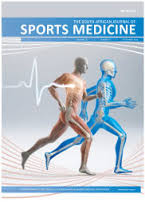An analysis of specific batting demands in the women’s The Hundred competition
DOI:
https://doi.org/10.17159/2078-516X/2023/v35i1a15056Abstract
Background: No research has investigated the shortest format of the game of cricket, The Hundred competition. Furthermore, women’s cricket research is particularly limited, with most focusing on injuries and little literature investigating specific batting demands. These demands are important if training programmes are to mimic the game’s movement patterns.
Objectives: The purpose of this study was to analyse specific batting demands and variables associated with the women’s The Hundred competition.
Methods: Thirty-one matches from the Women’s 2021 The Hundred competition were analysed using Hudl Sportscode Elite. Variables analysed included: bowler type (seam or spin), free hits, no ball runs, reason for no ball (height/wide/front foot), run scored (0, 1, 2, 3, 4, 6), type of key event (fall of wicket, bowling referral, batting referral, umpire referral, bowling time out, rain delay, or injury) as well as time between deliveries and sets, overall and between the power play and non-power play. A total of 6073 deliveries were analysed.
Results: A significant difference (p<0.05) was observed for time between deliveries for spin bowlers (26.90±22.16 s) compared to seam bowlers(31.70±20.37 s) as well as time between sets for the power play (58.00±13.28 s) and non-power play phases (63.70±42.00 s). Additionally, in the power play, most runs were made up of “1’s” and “4’s”. In the non-power play phase, “1’s” made up the biggest contribution of runs (as a percentage).
Conclusion: The fact that singles make up a significant portion of a typical match means that strength and conditioning coaches should incorporate high-intensity sprint-type training into training programmes to mimic these demands.
Downloads
Downloads
Published
Issue
Section
License
Copyright (c) 2023 South African Journal of Sports Medicine

This work is licensed under a Creative Commons Attribution 4.0 International License.
The South African Journal of Sports Medicine reserves copyright of the material published. The work is licensed under a Creative Commons Attribution 4.0 (CC BY 4.0) International License. Material submitted for publication in the South African Journal of Sports Medicine is accepted provided it has not been published elsewhere. The South African Journal of Sports Medicine does not hold itself responsible for statements made by the authors.
How to Cite
- Abstract 440
- PDF 441





.png)